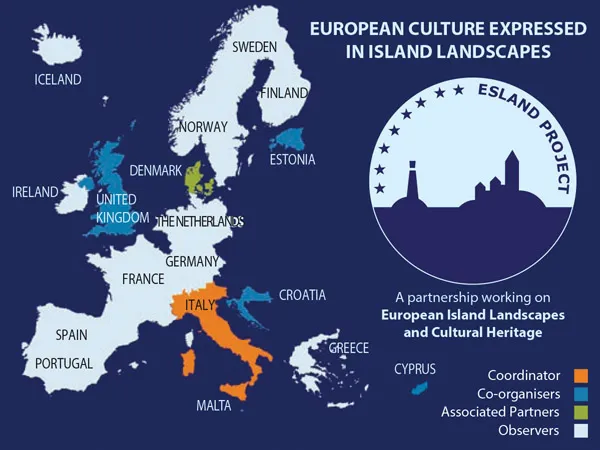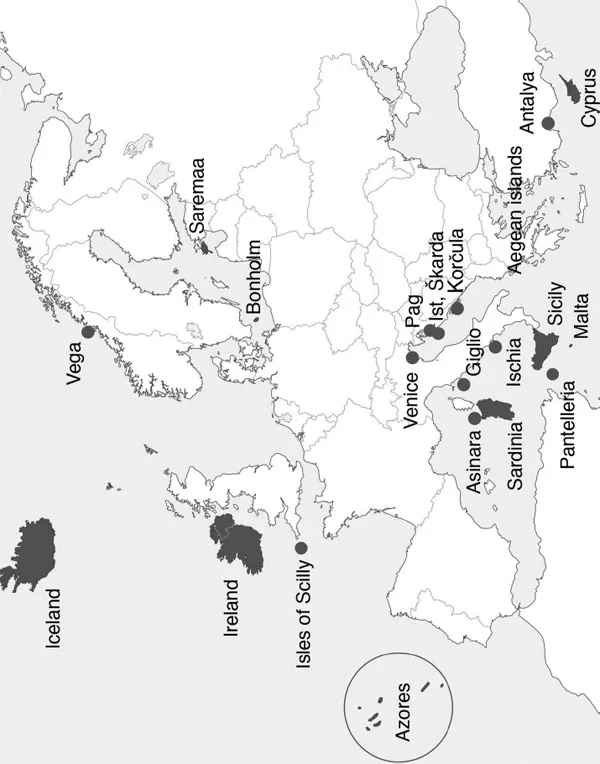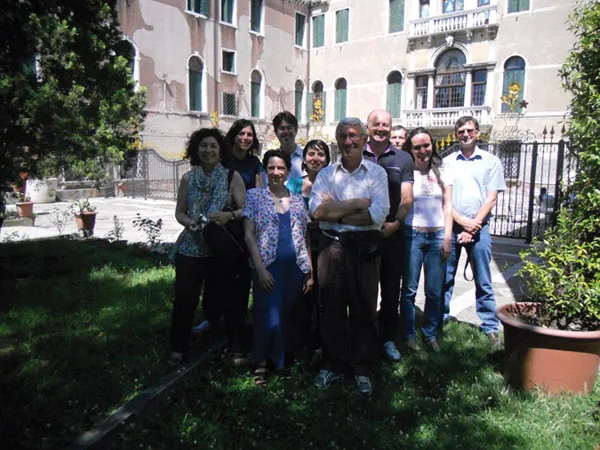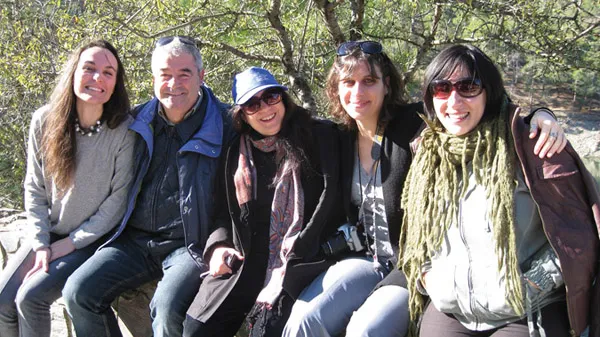![]()
1 Introduction
European culture, island landscape and the ESLAND perspective
Gloria Pungetti
Introduction
This book describes the changes in European island landscapes over time, their current conditions and future trends. It includes a discourse on the unique identities, heritage and values of islands of different sizes, and their relationships to the mainland. Rather than attempt the huge task of investigating all the islands of Europe, the work deals with a sample of contrasting islands, large and small, belonging to different countries and related to distinctive cultures.
This chapter explains the background of the entire work, the ESLAND Project, and the structure of the volume with its four Parts. Chapter 2, furthermore, sets the scene describing the subject of island landscape and cultural heritage in Europe, and introduces the key topics covered in the book, from island landscape history, characterisation and identity to island landscape scenario, planning and tools.
EUCEL: an expression of European culture
EUCEL is a trilogy of projects on European landscapes and cultural heritage under the Culture Programme 2007–2014 of the European Commission: EUCALAND investigating agricultural landscapes (Pungetti and Kruse, 2010); ESLAND exploring island landscapes (Pungetti, 2013); and ECSLAND contemplating sacred landscapes (Pungetti, 2015). EUCEL studies European cultural landscapes, considering them as a common cultural heritage, now under pressure from new developments. It provides novel directions in landscape research methodology, and cutting-edge tools for landscape science, planning and policy. This volume concentrates on the second project of the trilogy: ESLAND.
ESLAND: European Culture expressed in Island Landscapes
The ESLAND Project (European Culture expressed in Island Landscapes) aims to improve consideration of European island landscapes as part of our cultural heritage. The research methodology offers a holistic approach to the study of European island landscape and seascape based on previous research (see Pungetti, 1999). Accordingly, the project has studied the evolution of these landscapes and their present conditions, in view of an interdisciplinary approach for a common discussion and agreed methodology on their concepts, classification and identity.
This interdisciplinary project saw a multicultural cooperation between European institutions with expertise in the subject: IUAV University of Venice, University of Sassari and Sapienza University of Rome in Italy; CCLP University of Cambridge in the UK; Estonian University of Life Sciences in Estonia; UNEP Priority Action Programme in Croatia; Open University of Cyprus; and University of Copenhagen in Denmark (Figure 1.1). This partnership has been further enlarged by other organisations, together forming the ESLAND Network, which is now represented by 18 European countries and five extra-European countries.
The results of the project have been published in this book and in other publications. The project has also produced mapping and e-tools for the future development of European island landscapes and seascapes, which should be more culturally and sustainably oriented than at present.
The ultimate goal of ESLAND is to contribute to the implementation of European policies such as the European Landscape Convention of the Council of Europe (Pungetti, 2011), the UNESCO World Heritage Convention, the EC Maritime Spatial Planning and Integrated Coastal Zone Management, and the UNEP Mediterranean Action Plan.
This volume includes seven case studies of islands in the ESLAND Project: Venice and Sardinia in Italy, Isles of Scilly in the UK, Saaremaa in Estonia, Bornholm in Denmark, Korčula in Croatia, and Cyprus. Further research from the organisations of the ESLAND Network, on other islands in other regions of Europe, has also been considered. All the islands covered in the book are listed in Table 1.1 and indicated in Figure 1.2.
Figure 1.1 The ESLAND Project with logo, case studies and partnership.
Table 1.1 Islands covered in this volume, with country acronym, from north to south Europe | Islands |
| 1. Iceland, IC |
| 2. Ireland, IR |
| 3. Bornholm, DK |
| 4. Saaremaa, EE |
| 5. Venice, IT |
| 6. Murano, IT |
| 7. Pag, HR |
| 8. Skarda, HR |
| 9. Ist, HR |
| 10. Korčula, HR |
| 11. Giglio, IT |
| 12. Asinara, IT |
| 13. Sardinia, IT |
| 14. Ischia, IT |
| 15. Sicily, IT |
| 16. Pantelleria, IT |
| 17. Malta, MT |
| 18. Cyprus, CY |
| Archipelagos and Groups of Islands |
| 19. Vega Archipelago, NO |
| 20. Isles of Scilly, UK |
| 21. Azores, PT |
| 22. Aegean Islands, GR |
| 23. Antalya, TK (candidate country) |
Book structure
This book is not merely a collection of papers: it is the result of a proper endeavour to shape a methodology for researching European island landscapes and seascapes. During the ESLAND Project, novel methodological approaches on the subject were outlined, analysing the state of the art, designing development processes and applying the theory to case studies. This first approach was discussed with the ESLAND Network on several occasions, particularly at stakeholder workshops held on the islands of the project (Figures 1.3 and 1.4) and at the ESLAND Conference in Sassari in 2012. The methodology was then refined and is proposed here.
The main methods covered by this volume refer to four island landscape aspects: (1) history, (2) character, (3) identity, (4) scenario, planning and tools. Accordingly, the book has been divided into four parts with eight contributions, each part dealing with a key research topic. These topics often interlink with each other, and very often multiple topics can be found within just one chapter. In addition, each part has been divided, firstly into main chapters discussing key issues, research methodologies and approaches and, secondly, shorter case studies implementing the concepts illustrated in the main chapters. The result is a comprehensive description of advances in island landscape and seascape studies in Europe.
In this Introductory part of the volume, this chapter (Chapter 1) introduces the background of the full work and the structure of the book, while Chapter 2 discusses the fundamental topics covered by the authors.
Figure 1.2 The 18 islands and the four groups of islands of the 12 EU member States, and 1 island group of a candidate country, covered in this volume.
Figure 1.3 Participants of the ESLAND Project Meeting and Workshop held in Venice in 2011.
Figure 1.4 ‘Eslanders’, the members of the ESLAND Project, at the Meeting and Workshop held in Cyprus in 2011.
In Part I – Island Landscape History, Chapter 3 lays down the methodology to follow for the history of island landscapes in Europe. Applied to the Scilly Isles in the UK, it points out how a knowledge of island history is essential to understanding its landscape. The same methodology is also employed for the other three islands of the ESLAND Project: Saaremaa in Estonia (Chapter 4), Cyprus (Chapter 5) and Korčula in Croatia (Chapter 6). In Saaremaa, landscape has been radically changed and damaged under the Soviet regime, and new threats now arise from the globalisation of plants and plant diseases. In Cyprus, although the current political division of the island seems to have little effect on some landscape areas, in others the land has been abandoned for decades and now reveals a separate type of landscape. In Korčula, landscape and the environment have been preserved for hundreds of years as a result of the thirteenth-century Korčula Statute, one of the oldest Slav legal documents, but the recent pressure of economic progress and modernisation is now having a strong impact on the landscape.
The landscape evolution of another Mediterranean island, Ischia in Italy (Chapter 7), is then described, showing traditional techniques and land use that characterise the ancient landscape still present on the island.
To follow up, three case studies in another ESLAND island, Sardinia in Italy, are illustrated to apply the methodological approach to island landscape history: the cultural landscape of the olive groves around the royal cities of Sassari, Alghero and Bosa (Chapter 8); the different European cultures that have left their marks on the landscape of Asinara (Chapter 9); and the relationship between man and his environment in the prehistoric Gulf of Oristano (Chapter 10).
In Part II – Island Landscape Character, Chapter 11 attempts islandscape assessment in Cyprus, describing the island landscape and seascape character methodology discussed during the ESLAND Project, while also taking into account tangible and intangible cultural elements. Other approaches to island landscape character assessment are proposed by a Portuguese research team in Chapter 12, applied to the Azores, and used as tools for landscape classification and planning.
Island landscape character is also addressed from different angles in North West, South East and South West Europe. The first is the case of the Vega archipelago in Norway (Chapter 13) where the revitalisation of haymaking, grazing and eider duck farming have played a crucial role for understanding the island’s landscape character; not only in rediscovering old traditions and skills, but also in boosting tourism, increasing biodiversity and last but not least reinforcing the islanders’ identity. The second is the case of the islands of the Antalya region in Turkey (Chapter 14) where place names are a reflection of landscape character and convey a cultural knowledge embedded in their environment. The third is the case of the islands of Pantelleria and Giglio (Chapter 15) where vineyards and traditional techniques give a particular character to the agricultural landscape of these Italian islands.
Three case studies are used to apply the methodology explained in the main chapters of Part II: the application of ...




